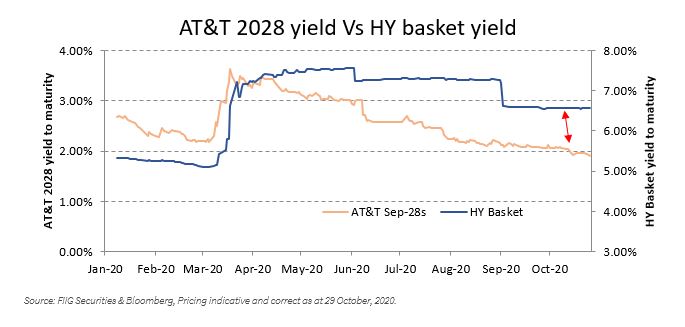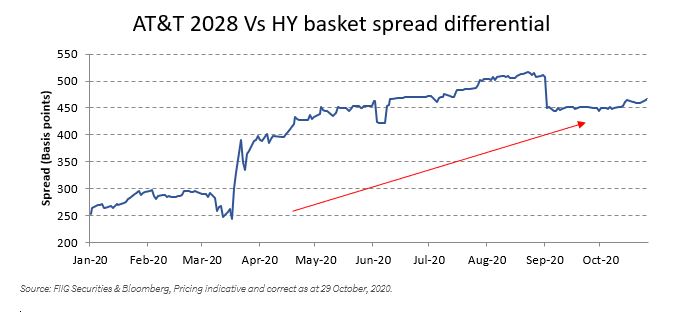Following the RBA’s further easing measures at its November meeting, in what is an already record-low interest rate environment, it begs the question of how to achieve a higher level of income? We believe the answer lies in part in shorter dated high yield bonds.
This document has been prepared by FIIG Investment Strategy Group. Opinions expressed may differ from those of FIIG Credit Research.
Background
With the RBA cutting the official cash rate to 0.10%, setting a target for the three-year Australian Government bond yield of around 0.10 per cent, short term rates are low and will remain so for some time yet. Previously investors seeking income could rely on purchasing longer dated bonds, as typically they pay a higher premium for the longer timeframe (as long-dated risk free rates and the risk premium have been higher). However, with a reduction in the difference between short-dated and long-dated government securities, this is slowly diminishing. Our colleagues in FIIG Research provide further details in their note, Lower for longer (...and longer).
High yield bonds have generally lagged the rally in investment grade bond markets following central bank intervention. However, we believe a measured exposure to short-dated, unrated (and higher yielding) bonds will provide a higher level of income for balanced portfolios for investors willing to take on credit risk.
In this note we examine a selection of unrated, shorter dated bonds that present an opportunity for investors seeking a higher portion of income.
The opportunity
During market uncertainty, higher yielding bonds generally represent a lower allocation in a portfolio owing to their higher risk profile. However, not all high-yield bonds are created equal, and selecting a highly diversified portfolio with strong individual credit characteristics or those within well-performing sectors can assist in achieving an overall higher portfolio return. Furthermore, inherently there is less risk in a shorter dated investment timeframe, as there is less uncertainty.
The chart below illustrates the reduced demand for credit risk throughout COVID-19, comparing the yield to maturity on the longer dated investment grade AT&T 2028 bond, versus the average yield to maturity of a basket of selective high yield bonds. The high yield basket of bonds includes SCT Fixed 2024, Omni Bridgeway 2026, Sunland 2024 and ZipMoney Trust 2017-1.
The AT&T 2028 yield (light brown line), increased by over 100 basis points (bps) or 1% at the height of COVID-19 (note that when yields increase, the capital price of the bond falls), but has since recovered and yields less than it did pre-COVID-19. Over the same timeframe, the average yield on the aforementioned high yield basket (dark blue line) increased by over 200bps but has since only recovered about half of that.

We can also look at this in terms of the spread differential between the two yields. The difference in yield between the AT&T 2028 and the high yield basket has continued to widen, from ~390bps at the height of COVID-19 to currently ~460bps. There has been a smaller amount of yield improvement in the high yield basket of bonds.

Short dated high yield bonds
The table below highlights a non-exhaustive list of some selective short dated bonds that we believe offer an opportunity for investors seeking a higher portion of income and willing to take credit risk. They are unrated bonds, and as such should be added in smaller positions to diversified portfolios. However, their performance through the COVID-19 pandemic has held up well, either owing to the underlying essential nature of their business (such as SCT Logistics) or because their operating revenues have not been impacted by COVID-19, such as Omni Bridgeway. Others, such as the Zip Co Limited, have arguably benefited from the pandemic.
FIIG Research provides a brief summary of recent performance directly below:
- SCT Logistics, an integrated freight forwarder and rail operator, has been declared an essential service, moving a significant portion of grocery product for supermarkets along its key logistical routes.
- Omni Bridgeway, the largest litigation funder in Australia, reported its highest level of earnings from litigation cases in its history for the year ended 30 June 2020. There is little to suggest there has been much of an impact on Omni’s earnings from COVID-19, given earnings are generated from investments in cases that commenced two-three years prior, and case disruptions from the pandemic have been fairly minimal.
- Sunland, an ASX listed residential property development group, recently announced a new strategic plan in an effort to lift its equity price. The plan is to complete and sell existing developments and sell all inventories (completed and undeveloped). From there, it will pay all creditors and return the rest to shareholders. The company is working on the basis the plan will take about 3 years to complete.
- Zip Co Limited (the originator and servicer for the ZipMoney 2017-B), an ASX listed provider of point-of-sale credit and digital payment services, appears to have been somewhat of a beneficiary of social distancing, with a significant proportion of sales transitioning to online channels. Arrears and charge-offs have generally trended higher, as expected, but it remain well-covered by various forms of credit enhancement.

Conclusion
With further easing measures announced by the RBA, it’s becoming harder for investors who are seeking a stronger income for their portfolios.
An opportunity exists in adding selective unrated short-dated bonds to portfolios (such as those highlighted above but your relationship manager may have other suggestions), where the credit has performed well throughout the pandemic. These bonds carry an inherently higher level of risk compared to investment grade bonds, but can increase the portfolio return in a measured manner, so should be considered as an addition to a balanced diversified portfolio.